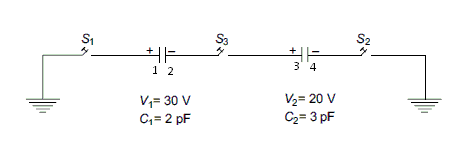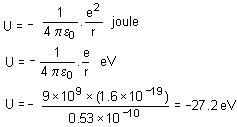Test: Electrostatic Potential and Capacitance - 2 - CUET MCQ
15 Questions MCQ Test - Test: Electrostatic Potential and Capacitance - 2
The work done in carrying a charge q around a circle of radius r with a charge Q at the centre is
Two point charges -q and +q are located at points (0, 0, - a) and (0, 0, a), respectively. What is the electric potential at point (0, 0, z)?
The electrostatic capacitance depends on
The electric potential V (in volts) varies with x (in metres) according to the relation V = 5 + 4x2. The force experienced by a negative charge of 2 x10-6 C, located at x = 0.5 m, is
Directions: In the following question, statement 1 (Assertion) is followed by statement 2 (Reason). Select the appropriate answer.
Statement 1: If an electron is moved from P to Q, its potential energy increases.
Statement 2: Potential at Q is less than that at P.
The capacitance of a sphere of radius R1 is increased 3 times when it is enclosed by an earthed sphere of radius R2. The ratio R2/R1 is
A parallel plate capacitor of capacitance 5 μF and plate separation 6 cm is connected to a 1 V battery and charged. A dielectric of dielectric constant 4 and thickness 4 cm is introduced between the plates of the capacitor. The additional charge that flows into the capacitor from the battery is
A parallel plate capacitor of plate area A and plate separation d is charged by a battery of voltage V. The work needed to pull the plates to a separation 2d, when the battery is disconnected, is
The potential difference between points A and B in the given circuit is
'n' identical condensers are joined in series and are charged to potential v. Now, they are separated and joined in parallel; then which of the following options is correct regarding the total energy and the potential difference of the combination?
Which of the following is true for the circuit shown in the figure?
In a hydrogen atom, the electron and the proton are bound together at a separation of about 0.53 Å. If the zero of potential energy is taken for an infinite separation of the electron from the proton, then the potential energy of the electron-proton system is
A soap bubble of radius r is charged to a potential V. If the radius is increased to nr, the potential of the bubble will become
What is the equivalent capacitance between A and D in the figure given below?
A cube of side b has a charge q at each of its vertices. What is the electric potential at the centre of the cube?




 , where A is the area of the plates and 'd' is the separation between the plates.
, where A is the area of the plates and 'd' is the separation between the plates. ,
,






 Hence W =
Hence W =  which is choice (3).
which is choice (3). 


















